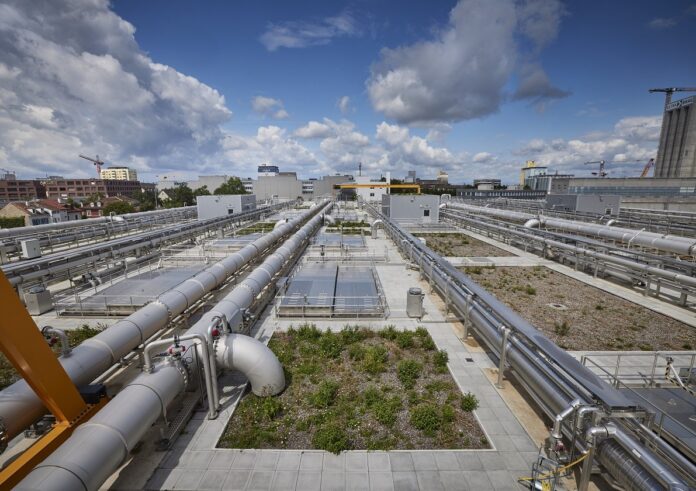Brought to you by Endress + Hauser
The Basel Wastewater Treatment Facility (ARA) has been in operation since 1982. After 40 years, the plant is reaching its limits in terms of age and capacity. In addition, the requirements and stipulations outlined in the water protection act have changed significantly with respect to microcontaminants. As operator of the ARA, ProRheno AG aims to meet these future requirements with the expansion and modernization of the facility. The large-scale project will be carried out with an extensive number of partners, including Endress+Hauser.
ARA Basel treats roughly 86,000 cubic metres of wastewater per day. 40 percent is produced by the households of Basel’s approximately 270,000 residents; the rest is generated by industry and businesses. While the new project plan and operational design takes into account further growth until 2040, the expansion provides additional goals and benefits:
- Reliable adherence to current regulatory threshold values
- Ease-of-implementation in response to strengthening of the water protection act, thus eliminating the need for new modifications
- Improved environmental and water protection
- Increased sustainability
ProRheno AG decided as early as 2008 to retrofit the ARA Basel treatment plant. From the beginning the plan was to implement the project without interrupting the operation of the plant. Large-scale projects like these call for forward-looking planning and the right partners. As is customary with municipal projects, all services and contracts were awarded through a tender offer. A reliable partner for the overall project planning and implementation was found in HOLINGER AG.
The tender offer stipulated that the instrumentation provider also cover installation, commissioning, training and documentation. As a complete provider, Endress+Hauser was awarded the contract. System integration and the step into the digital communications era via PROFINET was carried out in conjunction with Chestonag AG.

“Endress+Hauser has provided a large part of the instrumentation for our plant since 1982. Many factors contributed to the decision to select Endress+Hauser, including openness, regional proximity and reliability. Collaboration with the staff is excellent, even when something doesn’t run quite so smoothly,” comments Roberto Frei, Project Manager, ProRheno AG.
Wastewater treatment
The influent wastewater is pumped up to the level of the sewage work via pumping stations (Archimedean screw pumps). The fill level is monitored with Prosonic FDU91 ultrasonic sensors connected to an FMU90 transmitter in the machine room. ARA Basel utilizes four Archimedean screw pumps according to the amount of wastewater that accumulates. Solids are removed from the sewage in the downstream 3-bar screening system made up of coarse and fine rakes. The water level is measured before and after screening to determine the degree of contamination and to initiate cleaning of the rakes. Each of the six rakes is monitored with two Prosonic FMU40 ultrasonic sensors. There is even an escape hatch for wayward frogs. The solids from the rakes and the grit chamber are collected in troughs and then disposed of or reused. The fill levels in the troughs are monitored by Prosonic FMU41 ultrasonic sensors. Any grease that accumulates in the grease trap is fed to the fresh sludge stack. Additional coarse contaminants are removed in the six downstream primary sedimentation basins. At this point the mechanical treatment of the water is complete.
Biological treatment of the wastewater now takes place. ARA Basel decided on the sequence batch reactor (SBR) approach, which offers numerous advantages over conventional methods:
- Variable and compact design that takes up significantly less space
- High-performance, flexible purification
- Closed loop, better resource management
- Independent of influent fluctuations
The wastewater initially flows into one of the two SBR storage basins. From here the wastewater is directed to the nine SB reactors via the SBR pumping station, a process that is measured by Proline Progmag W 400 electromagnetic flowmeters with a nominal diameter of 600. The actual biological treatment occurs in the SB reactors and comprises the following processes: filling, denitrification (agitation), aeration, sedimentation, and decantation. This creates optimal conditions for the microorganisms in the activated sludge so that unwanted substances such as carbon, nitrogen and phosphorus compounds are broken down in the water. To function optimally, the activated sludge needs oxygen, which is forced into the reactors from below. The dosing of the precipitant for all relevant feed points, from the raw water pumping station to the sequence batch reactors, takes place from one central location.
The maneuverable float system, which features an integrated sensor plate, allows the analysis sensors to move around flexibly with the fill level of the sequence batch reactor. The float system is equipped with the following components:
- Oxymax COS61D – digital oxygen sensor with integrated temperature measurement
- Turbimax CUS51D – measurement of undissolved solids and turbidity
- Viomax CAS51D – digital nitrate sensor
- ISEmax CAS40D – digital ammonium sensor (one-off – sporadically used in the respective reactors for a certain amount of time)
The transmitter for the Liquiline CM448 analysis sensors, including PROFINET connectivity for control (PLC) purposes, is located near the edge of the basin, making it easy to access and calibrate. The sensors are automatically cleaned with compressed air. Digital communication via industrial Ethernet enables real-time transmission of value-added data, such as measurement and diagnostic information, directly to the control system. The activated sludge settles to the floor of the reactor at the end of the treatment cycle. The so-called surplus activated sludge is removed at regular intervals. Any floating sludge that forms on the surface is removed and collected in a duct. The fill level of the duct is reliably measured with the Micropilot FRM60 contactless radar-based instrument.
A clear water zone forms in the upper part of the SB reactors, which is fed to storage tanks and then to the next purification stage (microcontaminants) or discharged into the Rhine. Volume flow is measured by Proline Promag W 400 electromagnetic flowmeters with a nominal diameter of 700. As one would expect, the water quality is permanently monitored in order to adhere to the required guidelines.
Implementation of the fourth purification stage
ARA Basel has been successfully experimenting with the removal of microcontaminants such as pharmaceutical residues or microplastics for a number of years already. An innovative and future-proof process was selected for the fourth purification stage: the combination of ozonation and powder activated carbon dosing. This allows ARA Basel, as required by law, to remove 80 percent of the main substances in a reliable and stable manner.
Sludge treatment
All of the accumulated residual sludge (floating, primary and surplus) is currently collected, thickened, dehydrated and fed directly to the facility’s own incineration plant. The energy from the residual sludge is used to facilitate the incineration. The surplus heat has been fed to the city of Basel’s district heating network since 1999 and additionally has been used since 2009 in an energy center to generate cooling water or heating energy for a shopping center air conditioning system and industrial park in the vicinity.
Today there are other and better opportunities for using the residual sludge for energy purposes. The large-scale ARA Basel project will be expanded to include a sludge digestion system that produces digester gas, which is purified, treated and then fed into the municipal natural gas network as biogas – an important step towards increased sustainability.
ARA Basel is well-equipped for the future after completion of the three constructions phases. The following numbers make that more than clear:
- 1,100 tons of nitrogen – 70 percent of the total amount – are removed each year
- 80 percent of the microcontaminants are eliminated
- 90,000 norm cubic meters of exhaust are purified every hour
- Nine SB reactors are in operation, each with a capacity of 12,200 cubic meters
- COD (chemical oxygen demand) load of 62,400 kilograms per day
Do you want to know more on our products, solutions and services for the water & wastewater industry?
Visit us on www.endress.com/water-wastewater









